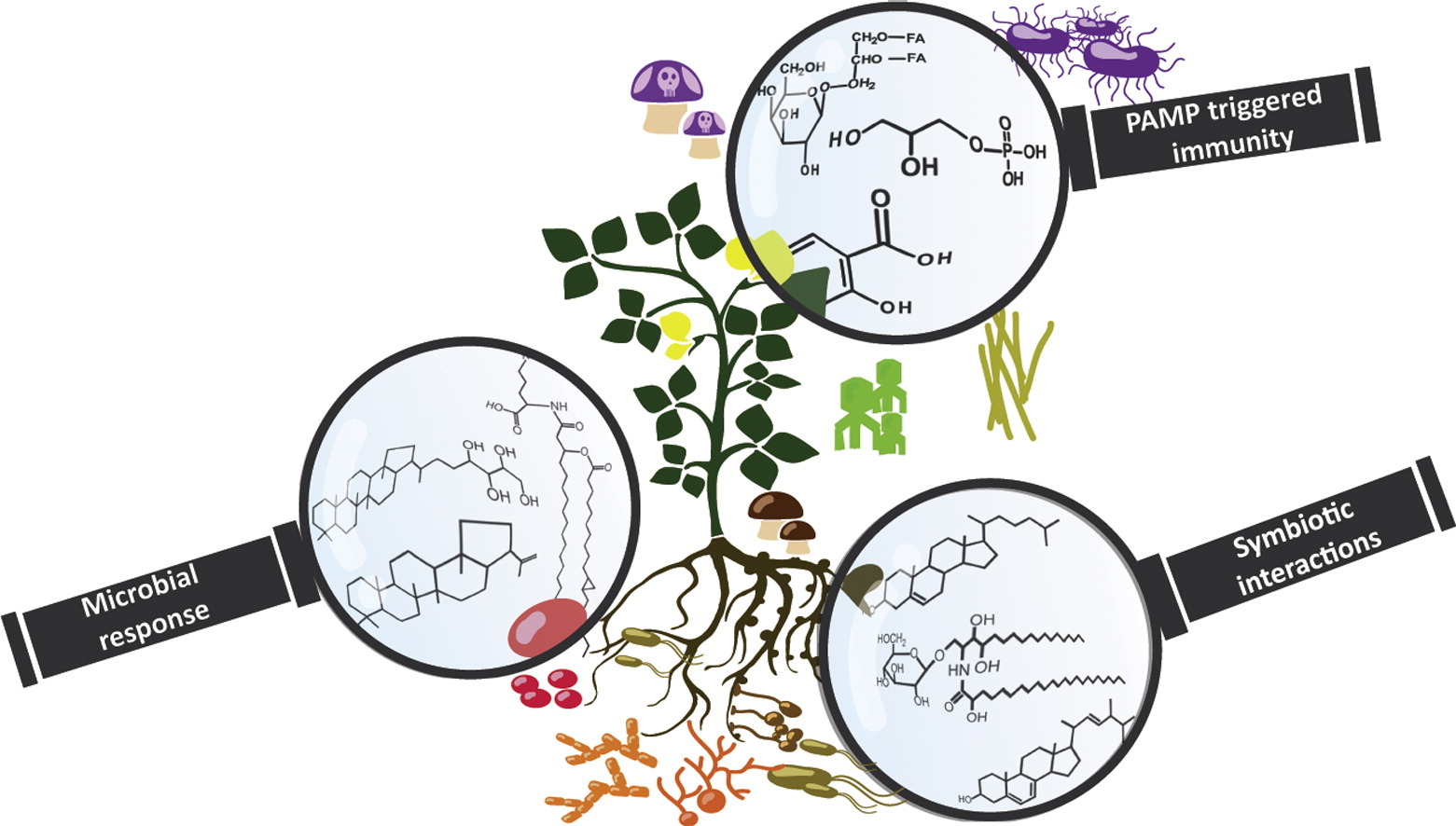Lipidomics in Plant-Microbe Interactions
Bacteria and fungi can undergo symbiotic or pathogenic interactions with plants. Membrane lipids and lipid-derived molecules from the plant or the microbial organism play important roles during the infection process. For example, lipids (phospholipids, glycolipids, sphingolipids, sterol lipids) are involved in establishing the membrane interface between the two organisms.
Furthermore, lipid-derived molecules are crucial for intracellular signaling in the plant cell, and lipids serve as signals during plant–microbial communication. These signal lipids include phosphatidic acid, diacylglycerol, lysophospholipids, and free fatty acids derived from phospholipase activity, apocarotenoids, and sphingolipid breakdown products such as ceramide, ceramide-phosphate, long chain base, and long chain base-phosphate.
 Fig1. Lipids in plant–microbe interactions (Siebers, Meike.; et al, 2016)
Fig1. Lipids in plant–microbe interactions (Siebers, Meike.; et al, 2016)
Phospholipids
Phospholipases and phospholipid-derived molecules are involved in signaling and plant immunity during plant–pathogen interactions. Upon microbe infestation, phospholipid-hydrolyzing enzymes are activated, contributing to the establishment of an appropriate defense response by inducing the production of defense-signaling molecules such as oxylipins, including jasmonic acid (JA), and the potent second messenger PA. Changes in phospholipid content and phospholipase activities during host–pathogen interactions or in elicited plant cells have been the focus of numerous studies.
Free fatty acids
Free fatty acid levels play a crucial role in plant–microbe interactions. Trienoic fatty acids (16:3, 18:3) play important roles in the regulation of plant defense responses. 18:3 is involved in defense responses against avirulent bacterial pathogens. Low levels of 18:3 in the Arabidopsis fad7fad8 mutant deficient in two ω-3 desaturases (FADs) led to a decrease in ROS accumulation, cell death initiation, and resistance to avirulent strains of P. syringae.
Phytosterol
Phytosterols are a class of steroidal compounds containing hydroxyl groups which exist in plants and have many physiological activities. Phytosterol is an important source of steroidal drugs, which has been widely used in food, feed, cosmetics, agricultural production, chemical industry, textile and other fields.
Sphingolipids
Sphingolipids are a diverse class of lipids that include small molecules involved in signaling as well as large glycosylated lipids that are essential for membrane integrity and membrane raft formation. Sphingolipids are involved in programmed cell death (PCD), a defense response against microbial pathogens.
In general, lipids under pathogen or herbivore attack are relevant in several respects: as components of mechanical barriers, as signaling molecules that participate in immunity cascades, as mediators of programmed cell death (PCD) associated with defense, and as antimicrobial or antifungal compounds. Lipidomic analysis contributed considerably to the unraveling of these roles. With decades of operational experience and technology platform, Creative Proteomics provides reliable, rapid, and cost-effective plant lipidomics services based on GC/LC-MS and shot-gun methods.
Features
- Compatible with a variety of types of samples, ranging from all kinds of plant organs and plant seeds to plant subcellular, etc;
- Creative Proteomics provides a comprehensive visual report of the results. The report will help to answer your study questions, and hopefully create a few new ones to follow;
- We will use our expertise to help you interpret the results and provide you with actionable recommendations on how to utilize these results in your research or business.
How we work in 7 easy steps

If you have any questions about our lipidomics services in plant-microbe interactions, please contact us. With our highly experienced scientific team, advanced techniques and equipment, we can tailor our services according to your needs.
Reference:
- Siebers, Meike.; et al. Lipids in plant–microbe interactions. Biochimica et Biophysica Acta (BBA)-Molecular and Cell Biology of Lipids. 2016, 1861.9: 1379-1395.
* Our services can only be used for research purposes and Not for clinical use.


 Fig1. Lipids in plant–microbe interactions (Siebers, Meike.; et al, 2016)
Fig1. Lipids in plant–microbe interactions (Siebers, Meike.; et al, 2016)

